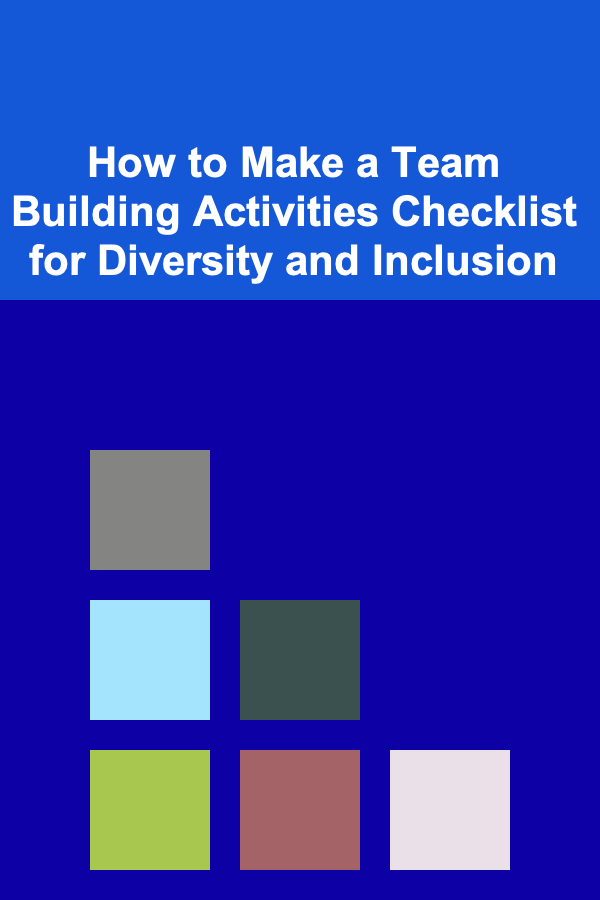
How to Make a Team Building Activities Checklist for Diversity and Inclusion
ebook include PDF & Audio bundle (Micro Guide)
$12.99$6.99
Limited Time Offer! Order within the next:

Creating a diverse and inclusive environment within a team is more than just a nice-to-have; it's essential for fostering innovation, collaboration, and employee satisfaction. One powerful way to build and maintain a diverse and inclusive culture is by implementing team-building activities designed to celebrate and promote these values.
However, ensuring that these activities are not only fun but also meaningful and inclusive requires careful planning and a deliberate approach. In this actionable guide, we will walk you through how to create a team-building activities checklist specifically tailored to fostering diversity and inclusion within your organization.
Understand the Importance of Diversity and Inclusion
Before diving into the creation of your checklist, it's crucial to understand the foundational importance of diversity and inclusion.
Why Diversity and Inclusion Matter
- Improved Problem Solving and Creativity: Teams composed of individuals from different backgrounds, perspectives, and experiences are better equipped to approach problems from multiple angles, leading to more innovative solutions.
- Enhanced Employee Engagement: When employees feel respected and included, they are more likely to be motivated, loyal, and committed to their work.
- Better Decision-Making: Diverse teams have a broader range of input, which can lead to better decision-making processes.
- Attraction and Retention of Talent: Organizations that actively promote diversity and inclusion are more likely to attract and retain top talent, creating a more dynamic and successful workforce.
Defining Diversity and Inclusion
- Diversity encompasses the different attributes that individuals bring to the table, including but not limited to race, ethnicity, gender, sexual orientation, disability, age, socio-economic background, and cognitive diversity.
- Inclusion involves creating an environment where all individuals feel valued, respected, and able to contribute fully, irrespective of their background or identity.
Identify Your Team's Unique Needs and Challenges
Every team is different, and the activities you plan should be tailored to your specific group. Start by identifying the unique challenges and needs of your team when it comes to diversity and inclusion.
How to Assess Your Team's Needs:
- Conduct Surveys or Interviews: Gather feedback from team members about their experiences with diversity and inclusion. Ask about any challenges they've encountered or improvements they'd like to see.
- Review Demographics: Understand the diverse backgrounds of your team members, including their cultural, ethnic, and gender identities. This will help you plan activities that resonate with everyone.
- Look at Past Initiatives: If you've previously conducted team-building activities, review their effectiveness in promoting diversity and inclusion. Were some activities more successful than others? Why?
Tip: Be mindful that diversity and inclusion aren't just about racial and ethnic differences; consider the full spectrum of diversity within your team, such as age, religion, ability, and neurodiversity.
Establish Clear Goals for Your Team Building Activities
The ultimate objective of your team-building activities is to create an environment where all team members feel valued, included, and empowered to succeed. Therefore, the activities you select must align with clear, specific goals.
Key Goals to Consider:
- Building Trust: Trust is the foundation of effective teamwork. Activities should foster trust and open communication among team members.
- Promoting Empathy: Helping team members better understand each other's lived experiences and perspectives is crucial for creating an inclusive environment.
- Encouraging Open Dialogue: Activities should encourage honest discussions about diversity and inclusion, creating space for team members to share their views and listen to others.
- Celebrating Diverse Backgrounds: It's essential to plan activities that actively celebrate cultural, ethnic, gender, and other forms of diversity.
Tip: Ensure your goals are measurable. For example, after completing a team-building activity, you could ask team members to rate how much more comfortable they feel with the concept of inclusion or whether they feel the activity promoted empathy.
Select the Right Activities for Diversity and Inclusion
Once you have a clear understanding of your team's needs and your goals, it's time to plan specific team-building activities. The key is to select activities that are both enjoyable and meaningful, while aligning with your diversity and inclusion objectives.
Activity Categories:
-
Icebreakers and Introductions: These are particularly important for teams that have diverse members from different backgrounds who might not know each other well.
- Example: "Cultural Icebreakers" - Ask each person to share one tradition, cultural practice, or interesting fact about their background. This can create an appreciation for cultural diversity and start the conversation about inclusion.
-
Collaborative Problem-Solving: These activities should focus on bringing together different viewpoints and working together to solve problems, thus reinforcing the value of diversity in thought and approach.
- Example: "Diversity Scenarios" - Present hypothetical workplace scenarios that involve diverse challenges, such as dealing with unconscious bias. Ask team members to work together to develop inclusive solutions.
-
Empathy-Building Exercises: Building empathy is essential for inclusion. Activities that challenge team members to see things from another's perspective can be highly impactful.
- Example: "Walk in My Shoes" - Ask team members to share a story from their life that shaped their perspective. Then, have others reflect on how they would feel in similar situations.
-
Celebration of Cultures and Backgrounds: Celebrate the richness of diversity by organizing activities that focus on learning about and appreciating different cultures and identities.
- Example: "Cultural Potluck" - Ask team members to bring in food, music, or traditions from their culture, allowing others to learn and engage in an inclusive environment.
-
Inclusive Language and Behavior Workshops: These workshops can address issues of bias, microaggressions, and inclusive communication.
- Example: "Inclusive Language Training" - Educate your team about the importance of inclusive language and how to avoid common pitfalls that can unintentionally alienate or exclude others.
Tip: Prioritize activities that involve interaction, as they help build connections among team members from different backgrounds.
Ensure All Activities Are Accessible and Inclusive
Accessibility is a fundamental component of inclusion. It's essential to ensure that every team member, regardless of their physical ability, gender identity, or background, can participate in your team-building activities.
Things to Consider for Accessibility:
- Physical Accessibility: If your team-building activities take place in person, ensure that the location is accessible to all team members, including those with physical disabilities. This might mean choosing venues with ramps, elevators, or accessible restrooms.
- Cultural Sensitivity: Be mindful of cultural differences when planning activities, including food choices, holiday observances, and religious practices. Ensure that all team members feel comfortable and respected in the activities you choose.
- Language and Terminology: Make sure that the language used in activities and discussions is inclusive and free from jargon that could exclude or confuse certain team members.
- Gender Inclusivity: Be careful with the language and structure of activities. For example, don't assume gender roles in team-building exercises, and avoid activities that could alienate people of different gender identities.
Tip: Regularly solicit feedback from team members to assess if any aspect of your team-building activities needs to be adjusted for better accessibility.
Evaluate and Refine Your Approach
After each team-building session, it's vital to evaluate its effectiveness and make improvements as needed. Continuous evaluation will ensure that your efforts to promote diversity and inclusion remain relevant and impactful.
How to Evaluate:
- Feedback Surveys: After each activity, ask team members for feedback. Questions could include: "Did you feel more included after the activity?" "Was there any moment that made you feel uncomfortable?" or "Do you feel that the activity helped you understand others' perspectives?"
- Team Reflection: Set aside time for the team to reflect on the activity together. Discuss what went well, what could be improved, and how the activity helped foster an inclusive environment.
- Monitor Progress Over Time: Track team dynamics over time to see if diversity and inclusion efforts are having a positive impact on collaboration, communication, and overall team morale.
Tip: Consistently refine and adapt your team-building activities based on the ongoing feedback and shifting needs of your team.
Conclusion
Creating a team-building activities checklist for diversity and inclusion is an intentional and thoughtful process. By understanding your team's needs, setting clear goals, selecting inclusive and meaningful activities, ensuring accessibility, and continuously evaluating your efforts, you can foster a more inclusive environment where everyone feels valued and empowered. Diversity and inclusion aren't just one-time initiatives; they require ongoing effort and commitment. When done right, your team-building activities will not only improve team cohesion but also cultivate an environment where innovation, respect, and collaboration thrive.

How to Incorporate Sustainable Holiday Decorations Into Your Home
Read More
How To Master Influencer Marketing for Small Businesses
Read More
How to Navigate Financial Stress and Stay Focused on Your Goals
Read More
The Art of Public Relations: Best Practices for Crafting Powerful PR Strategies
Read More
Mastering Underpainting for a Natural Finish
Read More
How To Start a Life Coaching Business
Read MoreOther Products

How to Incorporate Sustainable Holiday Decorations Into Your Home
Read More
How To Master Influencer Marketing for Small Businesses
Read More
How to Navigate Financial Stress and Stay Focused on Your Goals
Read More
The Art of Public Relations: Best Practices for Crafting Powerful PR Strategies
Read More
Mastering Underpainting for a Natural Finish
Read More